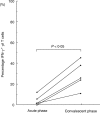Respiratory syncytial virus infection suppresses IFN-gamma production of gammadelta T cells
- PMID: 12562394
- PMCID: PMC1808627
- DOI: 10.1046/j.1365-2249.2003.02062.x
Respiratory syncytial virus infection suppresses IFN-gamma production of gammadelta T cells
Abstract
The immunological mechanisms by which respiratory syncytial virus (RSV) contributes to the development of asthma are poorly understood. gammadelta T cells are important in mucosal defence, and may contribute to the establishment of primary immune responses by producing cytokines early during respiratory infections. Thus, we used flow cytometry and intracellular cytokine staining to investigate the expression of interferon (IFN)-gamma and interleukin (IL)-4 by mitogen-stimulated gammadelta T cells from the peripheral blood of 15 hospitalized infants with RSV bronchiolitis, seven rotavirus-infected infants and eight normal controls. gammadelta T cells from RSV-infected infants had a lower proportion of IFN-gamma-producing cells (median, 4.00%; range, 0.58-6.60%) and a slightly but significantly higher proportion of IL-4-producing cells (median, 0.40%; range, 0.13-2.76%) than rotavirus-infected infants (median, 32.10%; range, 14.43-61.21%; P < 0.01, median, 0.00%; range, 0.00-0.00%; P < 0.05) in the acute phase. By contrast, differences in cytokine production by total CD3+ T cells did not differ significantly between patient groups. Thus, reduced IFN-gamma-production by gammadelta T cells in the peripheral blood of RSV-infected infants is accompanied by increased Th2 cytokine production during the acute phase of disease. At follow-up, eight children had recurrent episodes of wheezing. The frequencies of IFN-gamma-producing gammadelta T cells were significantly lower in patients who developed recurrent wheezing (median, 0.65%; range, 0.02-1.75%) than in patients without recurrent wheezing (median, 6.90%; range, 5.25-10.98%; P < 0.005). Cytokine production by gammadelta T cells may therefore be important in the pathogenesis of acute RSV disease, and play a part in the development of recurrent childhood wheezing after bronchilolitis.
Figures





Comment in
-
RSV bronchiolitis, gammadelta T cells and asthma: are they linked?Clin Exp Immunol. 2003 Feb;131(2):197-8. doi: 10.1046/j.1365-2249.2003.02086.x. Clin Exp Immunol. 2003. PMID: 12562377 Free PMC article. No abstract available.
Similar articles
-
Monocyte IL-10 production during respiratory syncytial virus bronchiolitis is associated with recurrent wheezing in a one-year follow-up study.Am J Respir Crit Care Med. 2000 May;161(5):1518-23. doi: 10.1164/ajrccm.161.5.9904078. Am J Respir Crit Care Med. 2000. PMID: 10806148
-
T helper 1/T helper 2 cytokine imbalance in respiratory syncytial virus infection is associated with increased endogenous plasma cortisol.Pediatrics. 2006 May;117(5):e878-86. doi: 10.1542/peds.2005-2119. Epub 2006 Apr 17. Pediatrics. 2006. PMID: 16618789
-
Enhanced IL-4 responses in children with a history of respiratory syncytial virus bronchiolitis in infancy.Eur Respir J. 2002 Aug;20(2):376-82. doi: 10.1183/09031936.02.00249902. Eur Respir J. 2002. PMID: 12212970
-
γδ T cells and the immune response to respiratory syncytial virus infection.Vet Immunol Immunopathol. 2016 Nov 15;181:24-29. doi: 10.1016/j.vetimm.2016.02.012. Epub 2016 Feb 21. Vet Immunol Immunopathol. 2016. PMID: 26923879 Review.
-
Immune and inflammatory response in bronchiolitis due to respiratory Syncytial Virus and Rhinovirus infections in infants.Paediatr Respir Rev. 2017 Sep;24:60-64. doi: 10.1016/j.prrv.2016.11.006. Epub 2017 Jan 16. Paediatr Respir Rev. 2017. PMID: 28159510 Review.
Cited by
-
The specific features of the developing T cell compartment of the neonatal lung are a determinant of respiratory syncytial virus immunopathogenesis.PLoS Pathog. 2021 Apr 28;17(4):e1009529. doi: 10.1371/journal.ppat.1009529. eCollection 2021 Apr. PLoS Pathog. 2021. PMID: 33909707 Free PMC article.
-
Analysis of circulating gammadelta T cells in children affected by IgE-associated and non-IgE-associated allergic atopic eczema/dermatitis syndrome.Clin Exp Immunol. 2005 Jul;141(1):116-21. doi: 10.1111/j.1365-2249.2005.02813.x. Clin Exp Immunol. 2005. PMID: 15958077 Free PMC article.
-
γδ-T cells: an unpolished sword in human anti-infection immunity.Cell Mol Immunol. 2013 Jan;10(1):50-7. doi: 10.1038/cmi.2012.43. Epub 2012 Oct 15. Cell Mol Immunol. 2013. PMID: 23064104 Free PMC article. Review.
-
Immunity Cell Responses to RSV and the Role of Antiviral Inhibitors: A Systematic Review.Infect Drug Resist. 2022 Dec 14;15:7413-7430. doi: 10.2147/IDR.S387479. eCollection 2022. Infect Drug Resist. 2022. PMID: 36540102 Free PMC article. Review.
-
Mast cell-induced lung injury in mice infected with H5N1 influenza virus.J Virol. 2012 Mar;86(6):3347-56. doi: 10.1128/JVI.06053-11. Epub 2012 Jan 11. J Virol. 2012. PMID: 22238293 Free PMC article.
References
-
- Everard ML, Milner AD. The respiratory syncitial virus and its role in acute bronchiolitis. Eur J Pediatr. 1992;151:638–51. - PubMed
-
- Weiss ST, Tager IB, Muoz A, Speizer FE. The relationship of respiratory infection in early childhood to the occurrence of increased levels of bronchial responsiveness and atopy. Am Rev Respir Dis. 1985;131:573–8. - PubMed
-
- Sly PD, Hibbert ME. Childhood asthma following hospitalization with acute viral bronchiolitis in infancy. Pediatr Pulmonol. 1989;7:153–8. - PubMed
-
- Welliver RC, Sun M, Rinaldo D, Ogra PL. Predictive value of respiratory syncytial virus-specific IgE responses for recurrent wheezing following bronchiolitis. J Pediatr. 1986;109:776–80. - PubMed
Publication types
MeSH terms
Substances
LinkOut - more resources
Full Text Sources
Medical

